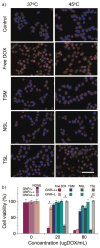Cooperative nanoparticles for tumor detection and photothermally triggered drug delivery
- PMID: 20217810
- PMCID: PMC3057607
- DOI: 10.1002/adma.200902895
Cooperative nanoparticles for tumor detection and photothermally triggered drug delivery
Figures




Similar articles
-
Bubble-generating nano-lipid carriers for ultrasound/CT imaging-guided efficient tumor therapy.Int J Pharm. 2017 Dec 20;534(1-2):251-262. doi: 10.1016/j.ijpharm.2017.07.081. Epub 2017 Aug 10. Int J Pharm. 2017. PMID: 28803939
-
Unstable reshaping of gold nanorods prepared by a wet chemical method in the presence of silver nitrate.J Nanosci Nanotechnol. 2006 Nov;6(11):3355-9. doi: 10.1166/jnn.2006.009. J Nanosci Nanotechnol. 2006. PMID: 17252764
-
Gold nanoparticles for photothermally controlled drug release.Nanomedicine (Lond). 2014 Sep;9(13):2023-39. doi: 10.2217/nnm.14.126. Nanomedicine (Lond). 2014. PMID: 25343351 Review.
-
Citrate-stabilized gold nanorods.Langmuir. 2014 Nov 25;30(46):13727-30. doi: 10.1021/la5029542. Epub 2014 Nov 7. Langmuir. 2014. PMID: 25254292 Free PMC article.
-
Liposomes as a Promising Ultrasound-Triggered Drug Delivery System in Cancer Treatment.Curr Mol Med. 2017;17(10):668-688. doi: 10.2174/1566524018666180416100142. Curr Mol Med. 2017. PMID: 29663885 Review.
Cited by
-
Phototriggered Drug Delivery Using Inorganic Nanomaterials.Bioconjug Chem. 2017 Jan 18;28(1):98-104. doi: 10.1021/acs.bioconjchem.6b00448. Epub 2016 Oct 7. Bioconjug Chem. 2017. PMID: 27661196 Free PMC article. Review.
-
Theranostic nanomedicine for cancer detection and treatment.J Food Drug Anal. 2014 Mar;22(1):3-17. doi: 10.1016/j.jfda.2014.01.001. Epub 2014 Jan 31. J Food Drug Anal. 2014. PMID: 24673900 Free PMC article. Review.
-
Fluorescence imaging enabled biodegradable photostable polymeric micelles.Adv Healthc Mater. 2014 Feb;3(2):182-6. doi: 10.1002/adhm.201300145. Epub 2013 Aug 26. Adv Healthc Mater. 2014. PMID: 23983129 Free PMC article.
-
Photoactive properties of supramolecular assembled short peptides.Chem Soc Rev. 2019 Aug 21;48(16):4387-4400. doi: 10.1039/c9cs00085b. Epub 2019 Jun 25. Chem Soc Rev. 2019. PMID: 31237282 Free PMC article. Review.
-
Multi-functional self-fluorescent unimolecular micelles for tumor-targeted drug delivery and bioimaging.Biomaterials. 2015 Apr;47:41-50. doi: 10.1016/j.biomaterials.2015.01.006. Epub 2015 Feb 4. Biomaterials. 2015. PMID: 25682159 Free PMC article.
References
-
- Weng KC, Noble CO, Papahadjopoulos-Sternberg B, Chen FF, Drummond DC, Kirpotin DB, Wang DH, Hom YK, Hann B, Park JW. Nano Lett. 2008;8:2851. - PubMed
-
- Tai LA, Tsai PJ, Wang YC, Wang YJ, Lo LW, Yang CS. Nanotechnology. 2009;20:135101. - PubMed
-
- Piao Y, Kim J, Bin Na H, Kim D, Baek JS, Ko MK, Lee JH, Shokouhimehr M, Hyeon T. Nat Mater. 2008;7:242. - PubMed
Publication types
MeSH terms
Substances
Grants and funding
LinkOut - more resources
Full Text Sources
Other Literature Sources

